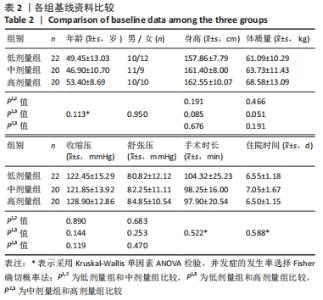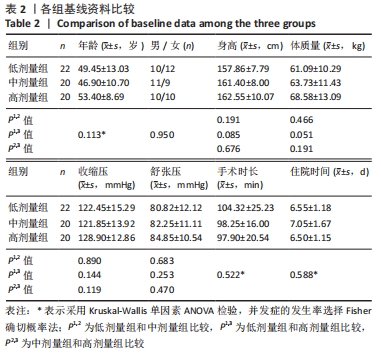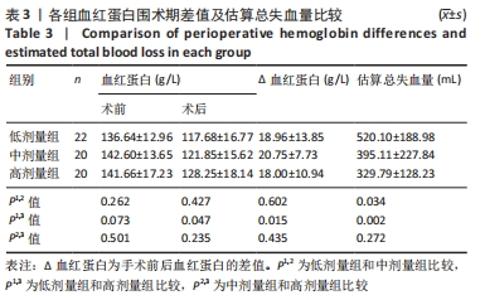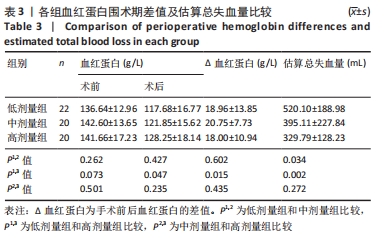Chinese Journal of Tissue Engineering Research ›› 2022, Vol. 26 ›› Issue (36): 5857-5861.doi: 10.12307/2022.789
Previous Articles Next Articles
Different doses of tranexamic acid affect blood loss after high tibial osteotomy
Sun Yiyuan1, Li Qi2, Xiong Yan2, Li Jian2
- 1Day Service Center, 2Department of Orthopedics, West China Hospital, Sichuan University, Chengdu 610041, Sichuan Province, China
-
Received:2021-09-24Accepted:2021-12-28Online:2022-12-28Published:2022-04-27 -
Contact:Li Qi, Associate professor, Master’s supervisor, Department of Orthopedics, West China Hospital, Sichuan University, Chengdu 610041, Sichuan Province, China -
About author:Sun Yiyuan, Master, Physician, Day Service Center, West China Hospital, Sichuan University, Chengdu 610041, Sichuan Province, China
CLC Number:
Cite this article
Sun Yiyuan, Li Qi, Xiong Yan, Li Jian. Different doses of tranexamic acid affect blood loss after high tibial osteotomy[J]. Chinese Journal of Tissue Engineering Research, 2022, 26(36): 5857-5861.
share this article
Add to citation manager EndNote|Reference Manager|ProCite|BibTeX|RefWorks
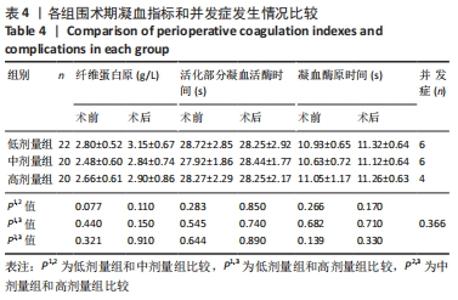
2.4 围术期出血情况 记录手术前后血红蛋白水平,计算各组手术前后的血红蛋白差值,估算失血量来对比各组间的差异性。术后各组血红蛋白水平均较术前减少,其中低剂量组术后血红蛋白水平显著低于高剂量组,差异有显著性意义(P < 0.05),但两组与中剂量组相比差异均无显著性意义(P > 0.05);手术前后血红蛋白差值比较,中剂量组与低、高剂量组之间差异均无显著性意义(P > 0.05),高剂量组与低剂量组之间差异有显著性意义(P < 0.05)。3组患者总失血量来看,随着氨甲环酸剂量增加,平均失血量逐渐减少,低剂量组和中、高剂量组之间差异均有显著性意义(P < 0.05),见表3。 2.5 凝血和并发症比较 各组术后的凝血指标相比差异无显著性意义,伤口未见感染征象,术后彩超未发现下肢深静脉血栓,无肺栓塞等事件发生。低、中、高剂量组中分别有6,6,4例患者出现发热,经治疗后好转,差异无显著性意义(P > 0.05);低剂量组中有1例患者出现术后低蛋白,输注人血白蛋白20 g后好转出院,所有患者均没有输血需求,见表4。"
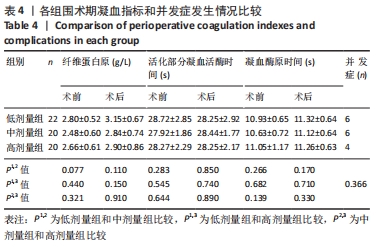
| [1] JACKSON JP, WAUGH W. Tibial Osteotomy for Osteoarthritis of the Knee. Proc R Soc Med. 1960;53(10):888. [2] COVENTRY MB. Osteotomy about the knee for degenerative and rheumatoid arthritis. J Bone Joint Surg. 1973;55(1):23-48. [3] PENG H, OU A, HUANG X, et al. Osteotomy Around the Knee: The Surgical Treatment of Osteoarthritis. Orthop Surg. 2021;13(5):1465-1473. [4] FLOERKEMEIER S, STAUBLI AE, SCHROETER S, et al. Outcome after high tibial open-wedge osteotomy: a retrospective evaluation of 533 patients. Knee Surg Sports Traumatol Arthrosc. 2013;21(1):170-80. [5] MARTIN R, BIRMINGHAM TB, WILLITS K, et al. Adverse event rates and classifications in medial opening wedge high tibial osteotomy. Am J Sports Med. 2014;42(5):1118-1126. [6] PAPE D, DUECK K, HAAG M, et al. Wedge volume and osteotomy surface depend on surgical technique for distal femoral osteotomy. Knee Surg Sports Traumatol Arthrosc. 2013;21(1):127-133. [7] KAWATA M, JO T, TAKETOMI S, et al. Type of bone graft and primary diagnosis were associated with nosocomial surgical site infection after high tibial osteotomy: analysis of a national database. Knee Surg Sports Traumatol Arthrosc. 2021;29(2): 429-436. [8] DELVA ML, SAMUEL LT, ROTH A, et al. Contemporary Knee Osteotomy in the United States: High Tibial Osteotomy and Distal Femoral Osteotomy Have Comparable Complication Rates despite Differing Demographic Profiles. J Knee Surg. 2021;34(8):816-821. [9] THIPPARAMPALL AK, GURAJALA I, GOPINATH R. The effect of different dose regimens of tranexamic acid in reducing blood loss during hip surgery. Indian J Anaesth. 2017;61(3):235-239. [10] ALSUMADI M, MAHMOOD A, WHITTAM D, et al. Efficacy and safety of tranexamic acid in hip fracture surgery: A comparative study of 613 patients. J Perioper Pract. 2021:17504589211002090. [11] ZHANG Z, WANG LN, YANG X, et al. The effect of multiple-dose oral versus intravenous tranexamic acid in reducing postoperative blood loss and transfusion rate after adolescent scoliosis surgery: a randomized controlled trial. Spine J. 2021;21(2):312-320. [12] D’SOUZA R, DUNCAN C, WHITING D, et al. Tranexamic acid is associated with decreased transfusion, hospital length of stay, and hospital cost in simultaneous bilateral total knee arthroplasty. Bosn J Basic Med Sci. 2021;21(4):471-476. [13] ZHU X, SHI Q, LI D, et al. Two Doses of Tranexamic Acid Reduce Blood Loss in Primary Posterior Lumbar Fusion Surgery: A Randomized-controlled Trial. Clin Spine Surg. 2020;33(10):E593-E597. [14] PALIJA S, BIJELJAC S, MANOJLOVIC S, et al. Effectiveness of different doses and routes of administration of tranexamic acid for total hip replacement. Int Orthop. 2021;45(4):865-870 [15] SONGLIN L, QUNSHAN L, MENG Z, et al. Effect of intravenous tranexamic acid on blood loss after high tibial osteotomy. J Clin Orthop Res. 2019;4(6): 343-348. [16] LI SL, LU QS, GUO XZ, et al. Intravenous Combined with Topical Tranexamic Acid Administration Has No Additional Benefits Compared with Intravenous Administration Alone in High Tibial Osteotomy: A Retrospective Case-Control Study. Orthop Surg. 2020;12(2):515-523. [17] 王军, 危杰, 王满宜. 股骨转子间骨折围手术期隐性失血量计算方法的分析[J]. 中华创伤骨科杂志,2014,16(5):437-440. [18] YOON SD, ZHANG G, KIM HJ, et al. Comparison of Cable Method and Miniaci Method Using Picture Archiving and Communication System in Preoperative Planning for Open Wedge High Tibial Osteotomy. Knee Surg Relat Res. 2016; 28(4): 283-288. [19] RAJESPARAN K, BIANT LC, AHMAD M, et al. The effect of an intravenous bolus of tranexamic acid on blood loss in total hip replacement. J Bone Joint Surg Br. 2009;91(6):776-783. [20] ZHOU Q, ZHOU YQ, WU HS, et al. Changes of Hemoglobin and Hematocrit in Elderly Patients Receiving Lower Joint Arthroplasty without Allogeneic Blood Transfusion. Chin Med J. 2015;128(1):75-78. [21] NI J, LIU J, ZHANG J, et al. Tranexamic acid is beneficial for blood management of high tibial osteotomy: a randomized controlled study. Arch Orthop Trauma Surg. 2020;141(9):1463-1472. [22] SUH DW, KYUNG BS, HAN SB, et al. Efficacy of Tranexamic Acid for Hemostasis in Patients Undergoing High Tibial Osteotomy. J Knee Surg. 2018;31(1):50-55. [23] PALANISAMY JV, DAS S, MOON KH, et al. Intravenous Tranexamic Acid Reduces Postoperative Blood Loss After High Tibial Osteotomy. Clin Orthop Relat Res. 2018;476(11):2148-2154. [24] KIM KI, KIM HJ, KIM GB, et al. Tranexamic acid is effective for blood management in open-wedge high tibial osteotomy. Orthop Traumatol Surg Res. 2018;104(7):1003-1007. [25] YAO R, GAO W, WANG B, et al. Efficacy and Safety of Tranexamic Acid in Reducing Blood Loss of Lower Extremity Osteotomy in Peri“cetabulum and High Tibia: A Systematic Review and Meta”nalysis. Orthop Surg. 2019; 11(4):545-551. [26] LI S, YANG J, WATSON C, et al. Drainage relieves pain without increasing post-operative blood loss in high tibial osteotomy: a prospective randomized controlled study. Int Orthop. 2020;44(6):1037-1043. [27] BOLAM SM, O’REGAN-BROWN A, PAUL MONK A, et al. Toxicity of tranexamic acid (TXA) to intra-articular tissue in orthopaedic surgery: a scoping review. Knee Surg Sports Traumatol Arthrosc. 2021;29(6):1862-1871. [28] SLATTERY C, KARK J, WAGNER T, et al. The Use of Tranexamic Acid to Reduce Surgical Blood Loss A Review Basic Science, Subspecialty Studies, and The Evolution of Use in Spine Deformity Surgery. Clin Spine Surg. 2019;32(2):46-50. [29] KIM MS, KOH IJ, SUNG YG, et al. Intravenous Tranexamic Acid Has Benefit for Reducing Blood Loss after Open-Wedge High Tibial Osteotomy: A Randomized Controlled Trial. J Clin Med. 2021;10(15):3272. [30] DRAXLER D, MEDCALF RL. The fibrinolytic system – more than fibrinolysis? Transfus Med Rev. 2015;29(2):102-109. |
| [1] | Liu Dongcheng, Zhao Jijun, Zhou Zihong, Wu Zhaofeng, Yu Yinghao, Chen Yuhao, Feng Dehong. Comparison of different reference methods for force line correction in open wedge high tibial osteotomy [J]. Chinese Journal of Tissue Engineering Research, 2022, 26(6): 827-831. |
| [2] | Xu Kuishuai, Zhang Liang, Chen Jinli, Ren Zhongkai, Zhao Xia, Li Tianyu, Yu Tengbo. Effect of force line changes on lower limb joints after medial open wedge high tibial osteotomy [J]. Chinese Journal of Tissue Engineering Research, 2022, 26(6): 821-826. |
| [3] | Pan Jianke, Zhao Di, Jin Xiao, Yang Weiyi, Luo Minghui, Liu Jun, Han Yanhong, Cao Houran. Implant-related errors and complications in medial open-wedge high tibial osteotomy [J]. Chinese Journal of Tissue Engineering Research, 2022, 26(36): 5849-5856. |
| [4] | Liu Jinlei, Yin Li, Zhang Yi, Wang Haitao, Lu Yingzi. Intra-articular tranexamic acid at different volumes and doses affects blood loss during total knee arthroplasty [J]. Chinese Journal of Tissue Engineering Research, 2022, 26(33): 5303-5310. |
| [5] | Qu Pengfei, Wang Huisheng, Li Xi. Correlation between blood loss during primary total knee arthroplasty and hypoalbuminemia and hypocalcemia after arthroplasty [J]. Chinese Journal of Tissue Engineering Research, 2022, 26(3): 376-382. |
| [6] | Liu Shaohua, Zhou Guanming, Chen Xicong, Xiao Keming, Cai Jian, Liu Xiaofang. Changes in kinematic parameters after unicompartmental knee arthroplasty and high tibial osteotomy [J]. Chinese Journal of Tissue Engineering Research, 2022, 26(3): 390-396. |
| [7] | Wang Jinjun, Deng Zengfa, Liu Kang, He Zhiyong, Yu Xinping, Liang Jianji, Li Chen, Guo Zhouyang. Hemostatic effect and safety of intravenous drip of tranexamic acid combined with topical application of cocktail containing tranexamic acid in total knee arthroplasty [J]. Chinese Journal of Tissue Engineering Research, 2021, 25(9): 1356-1361. |
| [8] | Zhang Chong, Liu Zhiang, Yao Shuaihui, Gao Junsheng, Jiang Yan, Zhang Lu. Safety and effectiveness of topical application of tranexamic acid to reduce drainage of elderly femoral neck fractures after total hip arthroplasty [J]. Chinese Journal of Tissue Engineering Research, 2021, 25(9): 1381-1386. |
| [9] | Chen Jinping, Li Kui, Chen Qian, Guo Haoran, Zhang Yingbo, Wei Peng. Meta-analysis of the efficacy and safety of tranexamic acid in open spinal surgery [J]. Chinese Journal of Tissue Engineering Research, 2021, 25(9): 1458-1464. |
| [10] | Huang Dengcheng, Wang Zhike, Cao Xuewei. Intravenous, topical tranexamic acid alone or their combination in total knee arthroplasty: a meta-analysis of randomized controlled trials [J]. Chinese Journal of Tissue Engineering Research, 2021, 25(6): 948-956. |
| [11] | Zhan Fangbiao, Cheng Jun, Zou Xinsen, Long Jie, Xie Lizhong, Deng Qianrong. Intraoperative intravenous application of tranexamic acid reduces perioperative bleeding in multilevel posterior spinal surgery: a meta-analysis [J]. Chinese Journal of Tissue Engineering Research, 2021, 25(6): 977-984. |
| [12] | Yuan Jun, Yang Jiafu. Hemostatic effect of topical tranexamic acid infiltration in cementless total knee arthroplasty [J]. Chinese Journal of Tissue Engineering Research, 2021, 25(6): 873-877. |
| [13] | Wang Qingwei, Wang Huasong, Huang Jifeng, Shi Huafeng, Hu Shouyong, Xie Hui. Intramedullary nail versus shoulder hemiarthroplasty for proximal humeral fractures with varus deformity: a retrospective non-random small-sample advantage analysis [J]. Chinese Journal of Tissue Engineering Research, 2021, 25(36): 5782-5786. |
| [14] | Wan Dadi, Duan Xiangrui, Fan Xinchao, Yuan Ye, Huang Teng, Pan Dikang, Liu Jingyan, Li Xicheng. Efficacy of posterior cruciate ligament retaining versus posterior stabilized prostheses in total knee arthroplasty: a systematic review and a meta-analysis [J]. Chinese Journal of Tissue Engineering Research, 2021, 25(36): 5897-5904. |
| [15] | Lin Xiaodong, Liu Wengang, Xu Xuemeng, Liu Xin, Lu Chao, Song Min, Li Congcong. Unicompartmental knee arthroplasty superior to open-wedge high tibial osteotomy: differences of mechanical parameters and knee function [J]. Chinese Journal of Tissue Engineering Research, 2021, 25(30): 4793-4798. |
| Viewed | ||||||
|
Full text |
|
|||||
|
Abstract |
|
|||||


